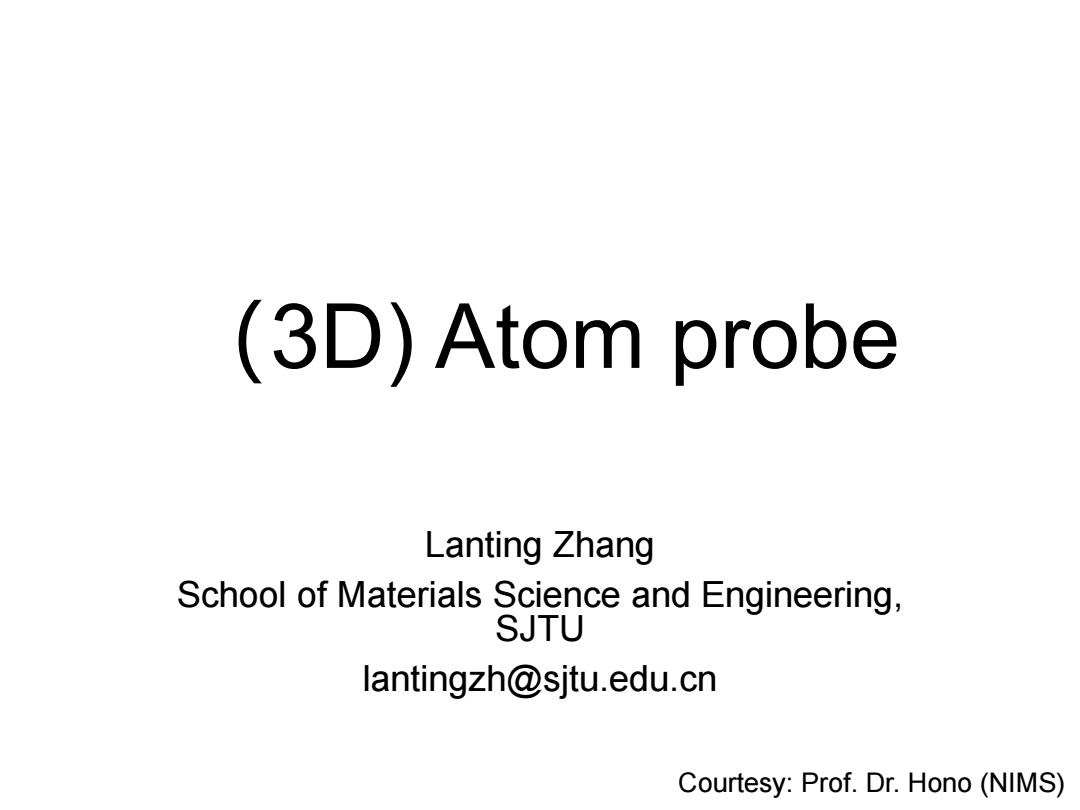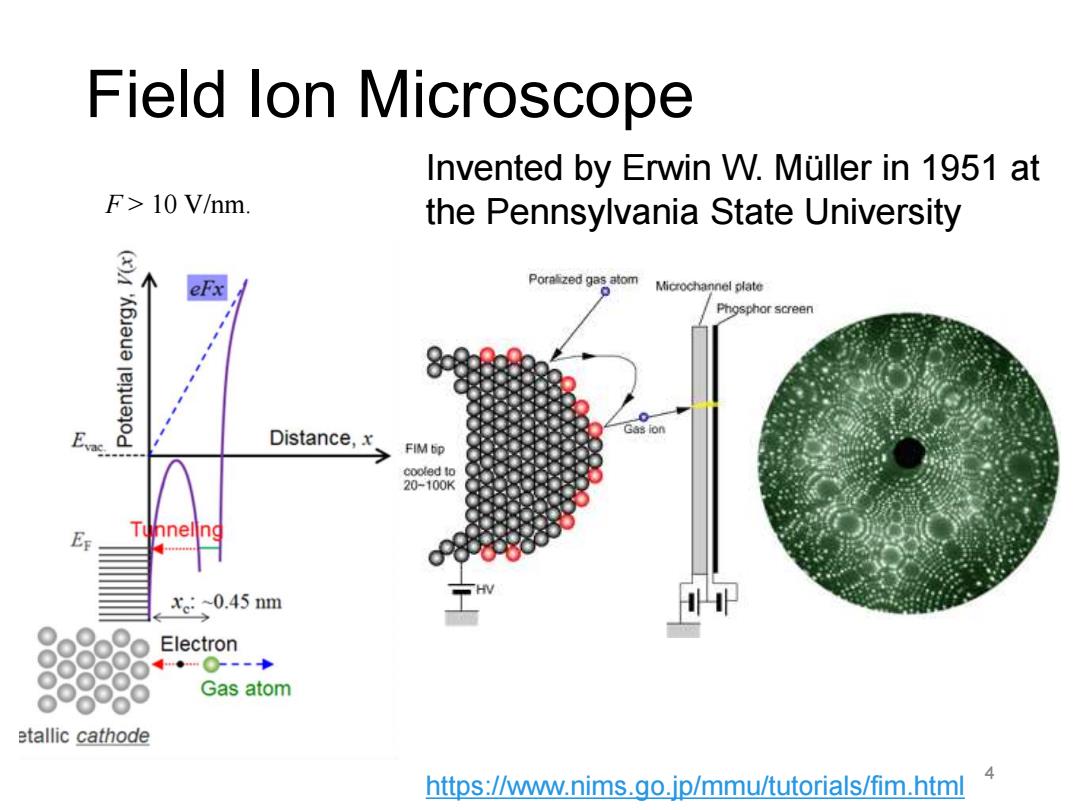
(3D)Atom probe Lanting Zhang School of Materials Science and Engineering SJTU lantingzh@sjtu.edu.cn Courtesy:Prof.Dr.Hono (NIMS)
(3D) Atom probe Lanting Zhang School of Materials Science and Engineering, SJTU lantingzh@sjtu.edu.cn Courtesy: Prof. Dr. Hono (NIMS)

Why atom probe? Chemistry at nano/atomic-scale The advantages and disadvantages of other way around?
Why atom probe? • Chemistry at nano/atomic-scale •The advantages and disadvantages of other way around? 2

Spatial resolution and detection limit 100% 10% TEM AES SEM Raman XPS XRD 1% FTIR 0.1% nano- SIMS WDS U-PIXE U-XRF XRF 100 ppm 10 ppm TOF-SIMS 1 ppm ICP-MS/ 100 ppb INAA SIMS LA-ICP-MS 10ppb APT Tppb 100 ppt Nano Micro Bulk 10 ppt Atom probe 0.1nm 1 nm 10 nm 100nm 1μm 10 um 100μm 1mm 1 cm tomography is superior in Elemental composition sensitivity and EDS EELS EBSD CL Structural information spatial resolution. Surface and thin film analysis ED EDS SEM and TEM host multiple techniques 3 http://www.ammrf.org.au/myscope/analysis/introduction/ TEM SEM
Spatial resolution and detection limit 3 http://www.ammrf.org.au/myscope/analysis/introduction/ Atom probe tomography is superior in sensitivity and spatial resolution

Field lon Microscope Invented by Erwin W.Muller in 1951 at F>10 V/nm. the Pennsylvania State University eFx Poralized gas atom Microchannel plate Phosphor screen Distance,x Gas ion E、w FIMbp cooled to 20-100K Tunnelng xe:-0.45 nm 88 Electron 4◆0--声 Gas atom etallic cathode https://www.nims.go.jp/mmu/tutorials/fim.html
Field Ion Microscope F > 10 V/nm. https://www.nims.go.jp/mmu/tutorials/fim.html Invented by Erwin W. Müller in 1951 at the Pennsylvania State University 4

This was the first time humans saw atoms some 2,400 years after Leucippus and Democritus postulated the existence of the "undividable"particle. (a) (b Helium in Professor Erwin W.Muller To pump (1911-1977) W Figure 1.10 The field-ion microscope was the first successful attempt to image'atoms':(a)A schematic diagram of the instrument;(b)a tungsten tip imaged by field-ion microscopy. 5
5 Professor Erwin W. Müller (1911–1977) This was the first time humans saw atoms some 2,400 years after Leucippus and Democritus postulated the existence of the “undividable” particle

Field ionization 10-Φ。 X。= The gas atoms are eventually Xc eF accommodated at crystal ledge He4.4×1010V/m and terrace sites before being Ne3.7×1010V/m ionised and field evaporated off H22.3×1010V/m the surface. a FIM image of Rhodium imaged in 20K/70 kV by Helium gas
Field ionization eF I x e c − = 0 He 4.4 ×1010 V/m Ne 3.7 ×1010 V/m H2 2.3 ×1010 V/m FIM image of Rhodium imaged in 20K/70 kV by Helium gas 6 The gas atoms are eventually accommodated at crystal ledge and terrace sites before being ionised and field evaporated off the surface

Field ion microscope(FIM) Invented by Erwin W.Muller in 1951 at the Pennsylvania State University 5~20kV Phosphor W a oc screen r~50 nm Cooled to 20~100K lonisation Imaging-gas supply V Field:= 20~30 V/nm; Magn:M=D ~X106 kr r 7
Field ion microscope (FIM) 7 Invented by Erwin W. Müller in 1951 at the Pennsylvania State University W kr V F = r D M = Cooled to 20~100 K 5~20 kV r~50 nm Field: Magn: ~x106 20~30 V/nm; 110

Field ion microscopy images (a) W () AI Cr-20Fe AlLi alloy (d) (e) Blunted Protruding Precipitate Precipitate -10nm 8 K.Hono /Progress in Materials Science 47(2002)621-729
Field ion microscopy images K. Hono /Progress in Materials Science 47 (2002) 621–729 W Al Cr-20Fe AlLi alloy 8

Field evaporation Field Evaporation is the field-induced removal of an atom from its own lattice at the presence of extremely high electric field of the order of a few V/nm. ∑1,-n neFx RQ,=A+2-陵 E Distance, M 33 Q(F)=2- F Atomic Q(F) 4π80 where &o is the dielectric Metallic cathode permittivity of the vacuum Cation 9 https://www.nims.go.jp/mmu/tutorials/FieldEvap.html
L e n i I − n 1 e n i Q = L +I − n 1 Q0 0 Q(F) F n e Q F Q 0 3 3 0 4 ( ) = − https://www.nims.go.jp/mmu/tutorials/FieldEvap.html Field evaporation Field Evaporation is the field-induced removal of an atom from its own lattice at the presence of extremely high electric field of the order of a few V/nm. 9 where ε 0 is the dielectric permittivity of the vacuum

Field evaporation Field Evaporation is the field-induced removal of an atom from its own lattice at the presence of extremely high electric field of the order of a few V/nm.8 6 A change in about 5%in 8 ◆W(110) the field can change the ■M0(110) ▲Hf(1010) evaporation rate by ■Ru(1121) ●r(100) between two and five Pt(100) orders of magnitude. 0 L 5 10 15 20 (F-F)Fo(%) vaporation rate:vexp(- Gault B.,Moody M.P.,Cairney J.M.,Ringer S.P.(2012)From Field Desorption Microscopy to Atom Probe Tomography.In:10 Atom Probe Microscopy.Springer Series in Materials Science,vol 160.Springer,New York,NY
) ( ) exp( 0 k T Q F v B evap = − Field evaporation Gault B., Moody M.P., Cairney J.M., Ringer S.P. (2012) From Field Desorption Microscopy to Atom Probe Tomography. In: Atom Probe Microscopy. Springer Series in Materials Science, vol 160. Springer, New York, NY Evaporation rate: A change in about 5% in the field can change the evaporation rate by between two and five orders of magnitude. 10 Field Evaporation is the field-induced removal of an atom from its own lattice at the presence of extremely high electric field of the order of a few V/nm